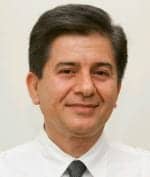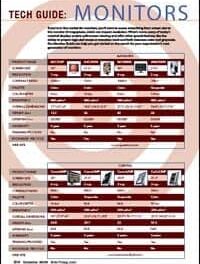
Chris Gaerig
With regard to third-party distributors and service companies, Irvine, Calif-based Ampronix Inc’s sales and repair departments may appear to operate like other organizations, but the company’s unique philosophy sets it apart from its competition. Ampronix aims to solve problems, and, as the company’s president and CEO, Nelson Fathollahi, explains, Ampronix does not try to offer the same product as its competitors in an Ampronix box. Instead, the company, through its research and development team, attempts to create products and solutions that fill in the missing link in the industry. 24×7 had a chance to sit down with Fathollahi to talk about the company’s philosophy, where it draws inspiration for new products, and how it has dealt with a tumultuous economy.
24×7: Can you tell me a bit about the history of Ampronix Inc?
Fathollahi: The company was established in 1982. We started by servicing all kinds of medical displays. After about 4 years, we added sales to our service offering. We continued to service displays and other products such as printers, recorders, and other video imaging devices—anything that has to do with imaging.
After a few years, we added a research and development (R&D) department. The purpose of the R&D department was to create solutions. We run into different customers all the time—including biomedical engineers—who have certain difficulties or obstacles. Our R&D department doesn’t think of things that already exist or that someone else already sells. The philosophy behind the department is to come up with a solution that is not addressed in the market.
24×7: Can you expand on your solution-based philosophy?
Fathollahi: Our focus was always trying to come up with solutions, not just products. The solutions would be valuable to the biomed engineers and the hospitals by saving costs, reducing downtime, or upgrading products to a level that would be more satisfactory. It’s always the same philosophy: Either something is missing and the solution is not there, or the product needs to be improved—it’s there but it’s not satisfactory. We’re trying to save the hospital cost and time, and save the biomed a lot of hassle of trying to come up with a solution. That’s what biomedical engineers go through every day. They face these challenges because there are so many systems that they have to maintain.
We are a valuable company because we create solutions. It’s not always clear what that solution is, but we work to solve problems. The general philosophy behind our own product line is only to solve a common problem within the industry. It’s not to bring a product in to compete with other manufacturers. We create solutions in areas that our partners have not been involved in. We’re the missing link.
24×7: Do you sell these solutions outside the United States?
Fathollahi: We are worldwide because this is a worldwide issue. What we sell in the US is primarily the service, but there are the same common problems that everyone has. In some countries there are more, and in some countries there are less, depending on the age of the systems, but pretty much, there are the same problems worldwide.
24×7: What is the most common solution biomeds are asking for now?
Fathollahi: The imaging displays seem to be the number one issue. Some units have an independent LCD display, which are not as complicated. But when a display is embedded inside a unit or inside a housing, those become more complicated, but we do have solutions for those as well.
24×7: What do you think is one of the biggest challenges facing biomeds today?
Fathollahi: I think they are realizing that the economy has had a major impact on the hospitals. Hospitals have to budget things. Within the biomed department, they have to carry on solving problems and finding solutions with fewer resources. This makes it more challenging for the biomeds, but we try to be realistic in our approach. Within any budget, we try to come up with a solution. There are different types of solutions at different costs.
A hospital or biomed will call us and say, “We need to replace this unit,” but then realize that a replacement is too expensive. We will then come up with a more affordable solution that will still solve their issue.
Biomeds have their own challenges every day dealing with different technical issues. To solve them, sometimes they have to purchase things, and the cost becomes an issue for them. We realize that hospitals are facing these financial challenges, and as such, we also provide solutions and work with these hospitals to assist in maintaining budgets by balancing services and quality.
24×7: How does your R&D department identify problems and solutions?
Fathollahi: The R&D department is under my direction, and what I do is have meetings every month with our salespeople and get feedback from them. Our sales department gets feedback about what sorts of issues and problems customers are having. Many years ago, people wanted to replace their CRT. They were asking for monitors that would work with all vendors. So we came up with a display that would work with any system.
We also monitor the trends of the industry and what is happening. We look at what products are having what types of issues and whether or not we can help or find a solution. But a lot of what R&D does comes from feedback from the sales department.
24×7: What are the benefits to offering such a diverse portfolio of solutions?
Fathollahi: Having a wide variety of products from a number of manufacturers is an advantage for the customers. A customer can call us and get any products that are out there from us. Let’s say someone wants a display for a PACS application. We represent multiple vendors so they don’t have to call each company. They can call us and get all of the information from price, to the application, to the condition, because we have our own survey of service and repair on all of these products. We know what the failure rate is on one particular model. So the customer can be a lot more calculated in their purchasing and be responsible about it using us. Not only do we have all of the different products, but we also have specific information about the quality.
Also, the customers can get all different products for different applications, not only displays. If they are looking to buy a printer or recorders, we offer all of these products for imaging. We have refurbished products, as well. If a customer wants to get refurbished products with some original condition, we completely refurbish them. We refurbish the inside and the cabinet. It looks like a brand-new piece.
24×7: What are some of the challenges of having a broad portfolio?
Fathollahi: The disadvantage is not so much on the customers’ side, but we have to deal with more manufacturers. To keep different manufacturers happy at the same level, if we sell four million of one product, we have to sell four million of another manufacturer’s. That’s a challenge, but we’ve been successful working with our partners. We’ve been very good at maintaining relationships with all of these partners. They see the value with our company. They see how we take off with one product and take it to a very high level. Once we believe in a particular product, whether it’s our product or someone else’s product, we’ll push that product and show the advantages of it. It’s a combination of things that we do to make people aware of the product.
As far as the customer’s contact with us, it’s an advantage to have all of those products on hand. The other thing is that we have a high volume of every brand so we can give them the best prices possible. It’s consolidated. If a customer calls us, because we buy such a high volume, we will have the best prices possible for the particular product that they’re asking for.
When the economy showed the first signs of going down, we actually saw an increase in business. There were some decisions made about what to do in 2009 and how we were going to continue in 2010 and 2011. In general, we did have a healthy, gradual increase—between 14% and 18%. Even in 2011, we had a 14% increase, even when the economy is showing its worst signs.
24×7: How closely does Ampronix work with biomeds?
Fathollahi: On a daily basis, we are in communication with biomedical engineers and hospitals. The biomeds call us for a particular service, or if they need to replace a unit. On a daily basis, we have probably 200 communications with biomeds or hospitals. They consult with us about a problem that they’re having or they might have to replace the unit, but we can have a 5-minute conversation and have a very decisive answer for the particular situation.
If there’s a technical issue, they call us. Even if they purchased the unit from someone else, they can call us for technical support. And we offer that support even if they bought it from someone else; it’s not a problem.
Chris Gaerig is the associate editor of 24×7. Contact him at .






